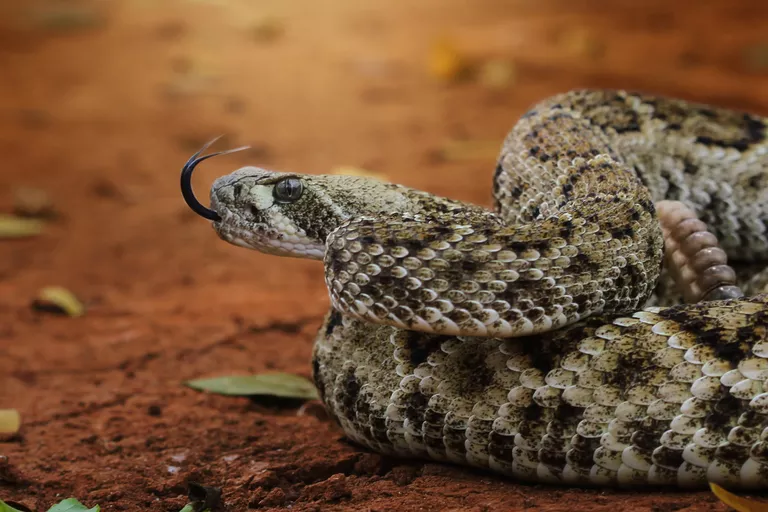Snake and Vipers
Snakes are reptiles. They are part of the order Squamata. They don't have legs, voice, ears, and eyelids. Despite this, snakes are successful carnivores. There are at least 20 families,and about 500 genera and 3,400 species.

They have a long, slender body, and are very mobile in their own way. Most of them live in the tropics. Very few snake species live beyond the Tropic of Cancer or Tropic of Capricorn, and only one species, the common viper (Vipera berus) lives beyond the Arctic Circle. Their skin is covered with scales. They can see well enough, and they can taste scents with their tongues by flicking them in and out. They are very sensitive to vibrations in the ground.
Though they do not have a voice, they can hiss. Most snakes live on the ground, others live in the water, and a few live under the soil. Like all reptiles, snakes need the heat of the sun to control their body temperature. That is why most snakes are in the warm, humid tropical regions of the world.
They range in size from the tiny, 10.4 cm-long thread snake to the reticulated python of 6.95 meters (22.8 ft) in length. The fossil Titanoboa was 12.8 meters (42 ft) long.
Snakes are found throughout the world except near the North and South poles. The tropics have the greatest variety. Most snakes live on the ground, but others prefer trees. Some snakes spend their whole lives in underground tunnels. Sea snakes live in water.
Snakes eat mice, rats, birds, frogs, fish, insects, lizards, eggs, and sometimes other snakes. Most snakes swallow their prey whole, usually head first. The prey may be dead or alive when eaten. Boas, pythons, king snakes, and rat snakes are called constrictors. They coil around their prey and constrict, or squeeze, the animal to death before eating it. Vipers and cobras kill their prey by shooting venom, or poison, into it through their fangs.
Without ears, snakes cannot hear most sounds. But they can sense when prey is near through vibrations in the ground. Snakes can see very well, too. Snakes flick out their tongue to “taste” the air, which gives them information about their surroundings. Snakes do not have a voice. However, they can make a hissing sound by sending air through an opening in the mouth.
A snake’s color can help protect it from enemies. Some snakes blend in with their surroundings. For example, many tree snakes are bright green and resemble vines. The bright colors of some snakes warn attackers that they are poisonous.
Snakes are cold-blooded animals. This means that their body temperature changes along with the temperature of their surroundings. To survive cold seasons, some snakes go into hiding places and become inactive for months at a time. This is like hibernation in mammals.
All About Vipers

Vipers are a family of venomous snakes, the Viperidae. All have long, hinged fangs that dig deep into their prey and inject venom. There are four subfamilies of the Viperidae.
Where does Viper live
Viper snakes are found in Americas, Africa, Eurasia. In the Americas they live from southern Canada, through the United States, Mexico, Central America, and into South America. The only type of viper which lives in the United Kingdom are the adders.
Fun Snake Facts
Check out our range of fun snake facts for kids. Learn about snake skin, snake charming, snake anatomy and much more.
Read on and enjoy a variety of interesting information about snakes.
-
Snakes are carnivores (meat eaters).
-
Snakes don’t have eyelids.
-
Snakes can’t bite food so have to swallow it whole.
-
Snakes have flexible jaws which allow them to eat prey bigger than their head!
-
Snakes are found on every continent of the world except Antarctica.
-
Snakes have internal ears but not external ones.
-
Snakes used in snake charming performances respond to movement, not sound.
-
There are around 3000 different species of snake.
-
Snakes have a unique anatomy which allows them to swallow and digest large prey.
-
Snakes are covered in scales.
-
Snakeskin is smooth and dry.
-
Snakes shed their skin a number of times a year in a process that usually lasts a few days.
-
Some species of snake, such as cobras and black mambas, use venom to hunt and kill their prey. Read more venomous snake facts.
-
Snakes smell with their tongue.
-
Pythons kill their prey by tightly wrapping around it and suffocating it in a process called constriction.
-
Some sea snakes can breathe partially through their skin, allowing for longer dives underwater.
-
Anacondas are large, non-venomous snakes found in South America that can reach over 5 m (16 ft) in length.
-
Python reticulates can grow over 8.7 m (28 ft) in length and are considered the longest snakes in the world.
Feeding
All snakes eat other animals. venomous snakes inject poison by grooves in their teeth. Constrictors are not venomous, so they squeeze their prey to death. They swallow their food whole, and they cannot chew. Because they are cold-blooded, they do not have to eat so regularly as mammals. People who own pet snakes feed them as infrequently as once per month. Some snakes can go as long as six months without a good meal.




